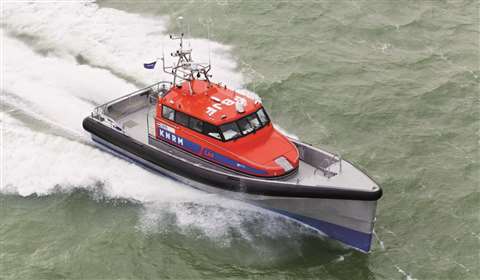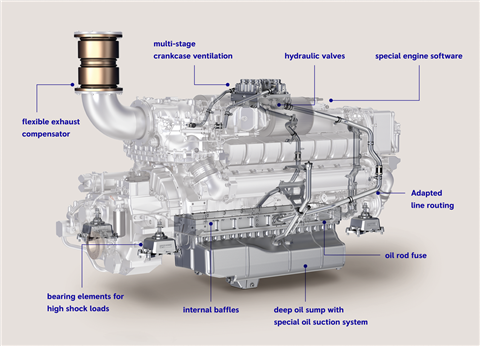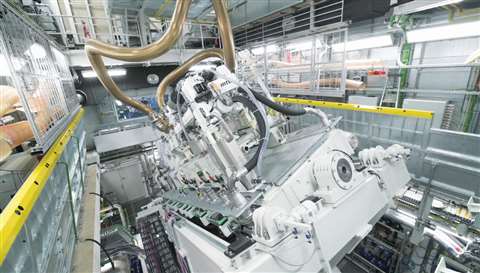How Rolls-Royce Power Systems digitized SAR kits
08 December 2021
mtu SAR systems help keep emergency vessels’ engines going in roughest conditions
When the weather is bad and sea conditions are at their worst, the prudent sailors sets a course for the nearest port or calmer waters.
But it’s exactly those times when emergency response vessels, such as search and rescue boats, do the opposite and head out to sea, often with lives in the balance.
Why is SAR important?
In such conditions, it’s critical that the engines powering emergency vessels keep operating, no matter the conditions. Now, mtu, a brand of Rolls-Royce Power Systems, has developed a new generation of search and rescue (SAR) engine kits that incorporate digital inclination sensing technology designed to enable emergency vessels powered by mtu Series 2000 engines to keep operating, even in seas turbulent enough to capsize the vessel.
 Rolls-Royce Power Systems has developed new technology for its mtu diesel engines designed for emergency vessels such as search and rescue (SAR) boats.
Rolls-Royce Power Systems has developed new technology for its mtu diesel engines designed for emergency vessels such as search and rescue (SAR) boats.
“That’s the thing about these vessels,” said Christoph Kern, an application engineer at Rolls-Royce Power Systems and head of SAR system sales. “When all the other boats come in, they go out. And they want to be able to rely on the engines and don’t want to worry about what to do because they’re maneuvering in high waves without power.”
What are the features of SAR?
The SAR systems can incorporate a range of features, such as extra-deep oil pans with special baffles to reduce splashing and specialized oil suction systems. “The baffles are designed to make sure the oil stays in the oil pan,” Kern said. “When you imagine jumping waves or high inclinations, the oil could just be very dynamic, and it could splash out of the oil pan or flow to places you don’t want to have the oil.
“The specialized suction has an optimized oil pan design and a robust piping which meets the rough requirements and fits and the shape of the oil pan. We designed the whole system in a way that we can get the oil from the really deepest point possible, which enables us to have higher inclinations.”
 Technology features of the mtu SAR system.
Technology features of the mtu SAR system.
Other components available in the SAR kits include flexible exhaust system connections, a modified crankcase breather system that incorporates a one-way valve designed to prevent oil or oil mist getting into the engine intake and causing uncontrolled combustion, even in 360º rollover conditions.
The biggest addition from mtu’s earlier SAR kits is a digital inclination sensor which constantly transmits position information to a dedicated software program which processes the signals and enables appropriate responses to protect the engines.
“We had these kinds of kits available for previous engines,” Kern said. “Now with the newest version of our Series 2000, we made it a system solution with the digital inclination sensor and special software.
How many SAR kits does Rolls-Royce offer?
“In the past, inclination sensing was all done basically by mercury switch so it could tell the automation system we are upside down or we are in the correct order. Those were the two possible positions
“With the new digital sensor, now we can measure the position of the ship in any time and then we made the software highly adaptable to the vessel design and to our engines. So now we can find, for every customer, the perfect fit between our engine capabilities and the vessel design.”
Rolls-Royce offers three SAR kits for use with the mtu Series 2000 engine. SAR 1 primarily targets fast, highly maneuverable planing vessels and includes bearing elements engineered to withstand shock loads up to 6 g vertical and 3 g lateral.
“This is mainly for smaller patrol craft like coastal services or coast guards around the world,” Kern said. “The intended purpose for them is to get very quickly to a point of interest like an emergency out on the sea, or illegal trafficking. The oil stays very set in the oil pan and we can make sure there are no oil level alarms in the engine, so the customers can go full speed, even when jumping over waves or having increased shock loads.”
How do SAR 1 and SAR 2 compare?
SAR 2 incorporates the SAR 1 features, along with being able to accommodate roll inclinations up to 45º and trim angles as high as 35º. “This has the larger and deeper oil pan, as well as the optimized crankcase ventilation system,” Kern said. “It allows the customers to have very high inclinations – up to 45º rolling is no problem at all. They can go full speed full load full power no alarms whatsoever.
“The intention is if search and rescue craft go out on high tides, high seas and extreme conditions, they can do so safely. The high waves and the high following inclinations will not harm the operation of the engine.”
SAR 3 “is our capsize kit,” said Kern. “This is the one for the most extreme conditions.
“It is designed for vessels which are capsize-ready, so they can do a full 360º capsize and then go on with their operations. With our engines that including that kit, the rollover is possible without switching off the engines. This gives the crew valuable seconds or minutes after the capsize event because you have to imagine when the engines are shut off during a capsize, the crew is in a state of shock. They have to sort themselves and then they have to go down to the engine room and restart the engine.
 The mtu SAR technology was extensively tested by Roll-Royce Power Systems using special test benches that can simulate dynamic wave motions and extreme angles of inclination and even a complete rollover.
The mtu SAR technology was extensively tested by Roll-Royce Power Systems using special test benches that can simulate dynamic wave motions and extreme angles of inclination and even a complete rollover.
“With mtu engines with this SAR kit, after they’ve sorted themselves out, they can just push on the (throttle) lever and go on with their operations. There is no engine starting procedure they have to do.”
The SAR kits were extensively tested by Rolls-Royce using test benches that can simulate dynamic wave motions and extreme angles of inclination and even a complete rollover. The systems are installed by Rolls-Royce and delivered to the customer fully integrated.
The latest mtu SAR system has been applied to new SAR vessels of the Italian Coast Guard and a firefighting vessel in Hong Kong. Rolls-Royce also has SAR application projects in Canada and the U.K. “We have got customers across Europe and have sold some engines in the African region,” said Kern. “We’ve got engines in Asia as well. We’re taking a global approach with this technology.”
STAY CONNECTED




Receive the information you need when you need it through our world-leading magazines, newsletters and daily briefings.
POWER SOURCING GUIDE
The trusted reference and buyer’s guide for 83 years
The original “desktop search engine,” guiding nearly 10,000 users in more than 90 countries it is the primary reference for specifications and details on all the components that go into engine systems.
Visit Now
CONNECT WITH THE TEAM









